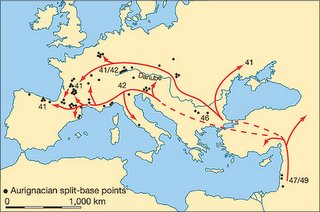The application of radiocarbon dating to these crucial early phases in modern human development has, however, been critically dependent on two potential sources of error in the accuracy of radiocarbon age estimates. The first is the impact of even miniscule quantities of contamination by more recent, intrusive carbon into the dated samples (Fig. 1a). This can be illustrated by the fact that contamination by only 1% of modern carbon in a sample actually 40,000 yr in age would reduce the measured age of the sample by over 7,000 yr... The second is the long-established recognition that the original proportion of 14C to 12C in the Earth's atmosphere has not remained constant over the past 50,000 yr, but has diverged sharply from present-day values, principally due to past variations in the intensity of the Earth's magnetic field and the shorter-term effects of sunspots on the amount of cosmic radiation reaching the upper atmosphere.
These problems can be overcome by using new pre-treatment techniques that remove newer carbon contaminants, and by making use of stratified carbon samples taken from deep-sea sediments.
The rapid spread of the early modern human populations was probably facilitated by a major improvement in climatic conditions in Europe between about 43,000–41,000 yr (calibrated) bp (the period of the Hengelo interstadial), which would inevitably have made a process of population expansion from southeast to northwest across Europe easier to achieve

This is all very interesting, but it should be noted that the author's inferences are based on radiocarbon dating of Aurignacian remains. While it is generally believed that the Aurignacian was a creation of anatomically modern humans, there is no smoking gun link between the Aurignacian and modern human remains. In fact, it could well be argued that pushing the date of the Aurignacian further back in time may lend some support to the idea that Neandertals produced at least some of the Aurignacian assemblages.
Nature 439, 931-935 (23 February 2006) | doi:10.1038/nature04521
A new radiocarbon revolution and the dispersal of modern humans in Eurasia
Paul Mellars
Abstract
Radiocarbon dating has been fundamental to the study of human cultural and biological development over the past 50,000 yr. Two recent developments in the methodology of radiocarbon dating show that the speed of colonization of Europe by modern human populations was more rapid than previously believed, and that their period of coexistence with the preceding Neanderthal was shorter.
Link

No comments:
Post a Comment